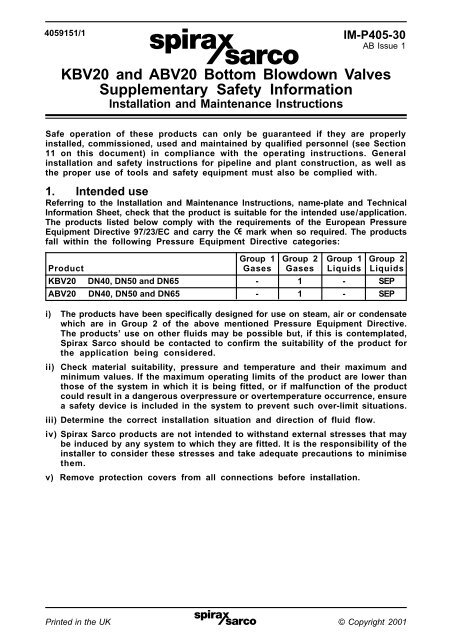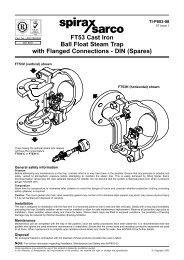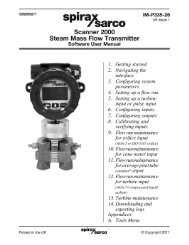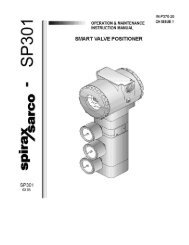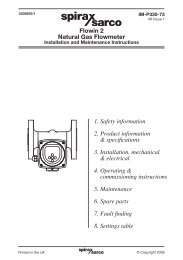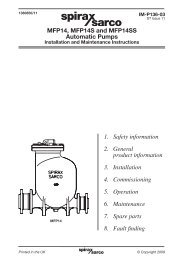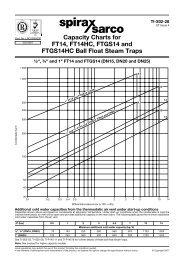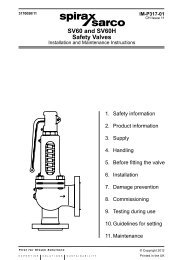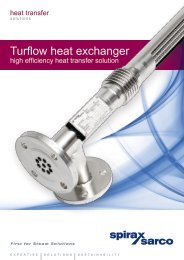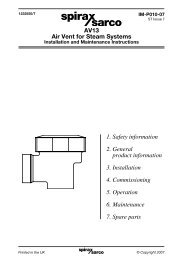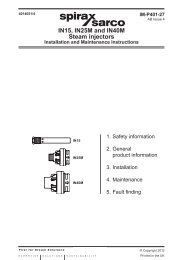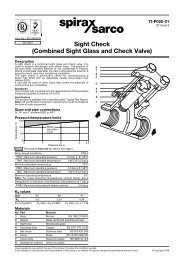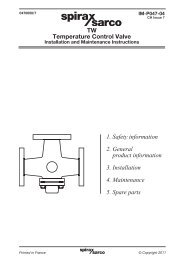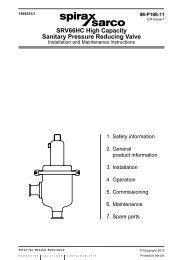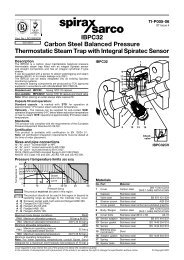KBV20 and ABV20 Bottom Blowdown Valves ... - Spirax Sarco
KBV20 and ABV20 Bottom Blowdown Valves ... - Spirax Sarco
KBV20 and ABV20 Bottom Blowdown Valves ... - Spirax Sarco
You also want an ePaper? Increase the reach of your titles
YUMPU automatically turns print PDFs into web optimized ePapers that Google loves.
4059151/1<br />
IM-P405-30<br />
AB Issue 1<br />
<strong>KBV20</strong> <strong>and</strong> <strong>ABV20</strong> <strong>Bottom</strong> <strong>Blowdown</strong> <strong>Valves</strong><br />
Supplementary Safety Information<br />
Installation <strong>and</strong> Maintenance Instructions<br />
Safe operation of these products can only be guaranteed if they are properly<br />
installed, commissioned, used <strong>and</strong> maintained by qualified personnel (see Section<br />
11 on this document) in compliance with the operating instructions. General<br />
installation <strong>and</strong> safety instructions for pipeline <strong>and</strong> plant construction, as well as<br />
the proper use of tools <strong>and</strong> safety equipment must also be complied with.<br />
1. Intended use<br />
Referring to the Installation <strong>and</strong> Maintenance Instructions, name-plate <strong>and</strong> Technical<br />
Information Sheet, check that the product is suitable for the intended use/application.<br />
The products listed below comply with the requirements of the European Pressure<br />
Equipment Directive 97/23/EC <strong>and</strong> carry the mark when so required. The products<br />
fall within the following Pressure Equipment Directive categories:<br />
Group 1 Group 2 Group 1 Group 2<br />
Product Gases Gases Liquids Liquids<br />
<strong>KBV20</strong> DN40, DN50 <strong>and</strong> DN65 - 1 - SEP<br />
<strong>ABV20</strong> DN40, DN50 <strong>and</strong> DN65 - 1 - SEP<br />
i) The products have been specifically designed for use on steam, air or condensate<br />
which are in Group 2 of the above mentioned Pressure Equipment Directive.<br />
The products’ use on other fluids may be possible but, if this is contemplated,<br />
<strong>Spirax</strong> <strong>Sarco</strong> should be contacted to confirm the suitability of the product for<br />
the application being considered.<br />
ii) Check material suitability, pressure <strong>and</strong> temperature <strong>and</strong> their maximum <strong>and</strong><br />
minimum values. If the maximum operating limits of the product are lower than<br />
those of the system in which it is being fitted, or if malfunction of the product<br />
could result in a dangerous overpressure or overtemperature occurrence, ensure<br />
a safety device is included in the system to prevent such over-limit situations.<br />
iii) Determine the correct installation situation <strong>and</strong> direction of fluid flow.<br />
iv) <strong>Spirax</strong> <strong>Sarco</strong> products are not intended to withst<strong>and</strong> external stresses that may<br />
be induced by any system to which they are fitted. It is the responsibility of the<br />
installer to consider these stresses <strong>and</strong> take adequate precautions to minimise<br />
them.<br />
v) Remove protection covers from all connections before installation.<br />
Printed in the UK © Copyright 2001
2. Access<br />
Ensure safe access <strong>and</strong> if necessary a safe working platform (suitably guarded)<br />
before attempting to work on the product. Arrange suitable lifting gear if required.<br />
3. Lighting<br />
Ensure adequate lighting, particularly where detailed or intricate work is required.<br />
4. Hazardous liquids or gases in the pipeline<br />
Consider what is in the pipeline or what may have been in the pipeline at some<br />
previous time. Consider: flammable materials, substances hazardous to health,<br />
extremes of temperature.<br />
5. Hazardous environment around the product<br />
Consider: explosion risk areas, lack of oxygen (e.g. tanks, pits), dangerous gases,<br />
extremes of temperature, hot surfaces, fire hazard (e.g. during welding), excessive<br />
noise, moving machinery.<br />
6. The system<br />
Consider the effect on the complete system of the work proposed. Will any proposed<br />
action (e.g. closing isolation valves, electrical isolation) put any other part of the<br />
system or any personnel at risk?<br />
Dangers might include isolation of vents or protective devices or the rendering<br />
ineffective of controls or alarms. Ensure isolation valves are turned on <strong>and</strong> off in a<br />
gradual way to avoid system shocks.<br />
7. Pressure systems<br />
Ensure that any pressure is isolated <strong>and</strong> safely vented to atmospheric pressure.<br />
Consider double isolation (double block <strong>and</strong> bleed) <strong>and</strong> the locking or labelling of<br />
closed valves. Do not assume that the system has depressurised even when the<br />
pressure gauge indicates zero.<br />
8. Temperature<br />
Allow time for temperature to normalise after isolation to avoid danger of burns.<br />
9. Tools <strong>and</strong> consumables<br />
Before starting work ensure that you have suitable tools <strong>and</strong>/or consumables<br />
available. Use only genuine <strong>Spirax</strong> <strong>Sarco</strong> replacement parts.<br />
10. Protective clothing<br />
Consider whether you <strong>and</strong>/or others in the vicinity require any protective clothing<br />
to protect against the hazards of, for example, chemicals, high/low temperature,<br />
radiation, noise, falling objects, <strong>and</strong> dangers to eyes <strong>and</strong> face.<br />
2<br />
IM-P405-30 AB Issue 1
11. Permits to work<br />
All work must be carried out or be supervised by a suitably competent person.<br />
Installation <strong>and</strong> operating personnel should be trained in the correct use of the<br />
product according to the Installation <strong>and</strong> Maintenance Instructions.<br />
Where a formal 'permit to work' system is in force it must be complied with. Where<br />
there is no such system, it is recommended that a responsible person should know<br />
what work is going on <strong>and</strong>, where necessary, arrange to have an assistant whose<br />
primary responsibility is safety.<br />
Post 'warning notices' if necessary.<br />
12. H<strong>and</strong>ling<br />
Manual h<strong>and</strong>ling of large <strong>and</strong>/or heavy products may present a risk of injury. Lifting,<br />
pushing, pulling, carrying or supporting a load by bodily force can cause injury<br />
particularly to the back. You are advised to assess the risks taking into account the<br />
task, the individual, the load <strong>and</strong> the working environment <strong>and</strong> use the appropriate<br />
h<strong>and</strong>ling method depending on the circumstances of the work being done.<br />
13. Residual hazards<br />
In normal use the external surface of the product may be very hot. If used at the<br />
maximum permitted operating conditions the surface temperature of some products<br />
may reach temperatures of 208°C (406.4°F).<br />
Many products are not self-draining. Take due care when dismantling or removing<br />
the product from an installation (refer to 'Maintenance instructions').<br />
14. Freezing<br />
Provision must be made to protect products which are not self-draining against<br />
frost damage in environments where they may be exposed to temperatures below<br />
freezing point.<br />
15. Disposal<br />
Unless otherwise stated in the Installation <strong>and</strong> Maintenance Instructions, this<br />
product is recyclable <strong>and</strong> no ecological hazard is anticipated with its disposal<br />
providing due care is taken.<br />
16. Returning products<br />
Customers <strong>and</strong> stockists are reminded that under EC Health, Safety <strong>and</strong><br />
Environment Law, when returning products to <strong>Spirax</strong> <strong>Sarco</strong> they must provide<br />
information on any hazards <strong>and</strong> the precautions to be taken due to contamination<br />
residues or mechanical damage which may present a health, safety or<br />
environmental risk. This information must be provided in writing including<br />
Health <strong>and</strong> Safety data sheets relating to any substances identified as hazardous<br />
or potentially hazardous.<br />
IM-P405-30 AB Issue 1 3
4<br />
IM-P405-30 AB Issue 1


